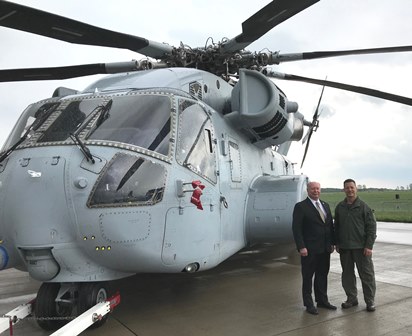
By J. Craig Tallman
Thursday, May 3, 2018
I had the opportunity this past April to attend the world’s oldest air show – the Innovation and Leadership in Aviation exhibition in Berlin, Germany.
The 109-year-old event featuring the latest innovations in aviation and space travel had more than 1,100 exhibitors from 40 countries showcasing aircraft and aerospace technologies.
My trip kicked off by attending a U.S. Embassy reception, followed by two days at the show, where I could learn first-hand about trends in civil and military aviation propulsion, avionics, unmanned aviation vehicles (drones), support services and training.
The Naval Air Systems Command, just across the Chesapeake Bay at Patuxent River, was well represented in Berlin.
I had the honor of meeting and talking with 93-year-old Sergei I. Sikorsky, the son of helicopter inventor Igor Sikorsky, and former president of Sikorsky Aircraft Corporation. We discussed the different approaches tried to counter the torque of a helicopter’s rotor system. He presented me with a signed copy of his book, The Sikorsky Legacy.
I saw the debut flight of the U.S. Marine Corp’s new (Sikorsky) CH-53K Heavy Lift Helicopter. It is the most powerful U.S.-made helicopter ever built and features three new engines, composites in the fuselage, more-efficient rotor blades and a triple-redundant fly-by-wire system. I also spoke with Marine test pilot Lt. Col. Johnathan Morel, who called the “King Stallion … a dream to fly.”

I heard Wolfgang Gaertner, a MTU Aero Engines’ engineer, discuss his industry-leading firm’s expertise in turbines and high-pressure compressors. The company is a partner with many firms – General Electric, Rolls Royce, Safran and Pratt & Whitney – in design, production, service and support, around the world.
I sat in on a presentation by Rear Admiral Francis D. Morley, Director of Navy International Programs Office, who talked about the benefits of U.S. participation in and support for air shows. He said they enable government and industry leaders to meet efficiently (Morley had 12 meetings in two days at one location) with aviation professionals from around the world. Decision-makers can see the latest technology and have candid information exchanges, and the venues help build relationships based on common understandings.
Attending the airshow was a great experience and I encourage other UMES students to attend conferences in their fields of study.
Tallman is a junior from Berlin, Md., enrolled in the professional pilot track of the aviation science curriculum and is currently pursuing his commercial airplane license.

